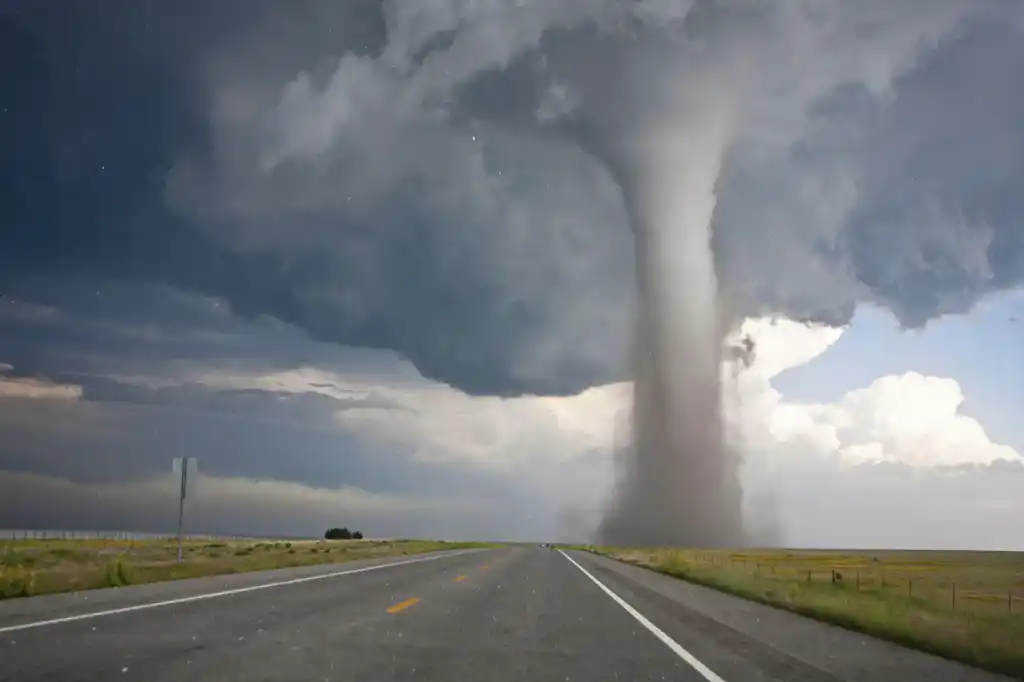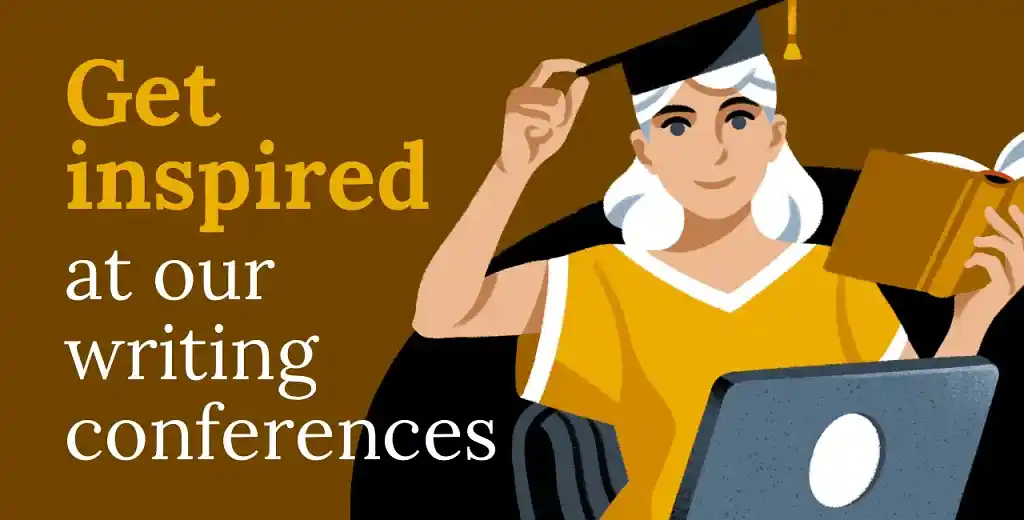Posted on Aug 21, 2025
What is Imagery? 7 Types and Examples of Imagery
Linnea Gradin
The editor-in-chief of the Reedsy Freelancer blog, Linnea is a writer and marketer with a degree from the University of Cambridge. Her focus is to provide aspiring editors and book designers with the resources to further their careers.
View profile →Imagery is a literary device where you create mental images of how something looks or feels through the written word, using figurative language. It’s not just limited to visual description, either; in fact, there are seven different types of imagery which appeal to all of our senses! These are visual (sight), auditory (sound), olfactory (smell), gustatory (taste), tactile (touch), kinesthetic (movement), and organic (internal feelings) imagery.
When used well, imagery infuses a narrative with symbolism and engages readers on a deeper, more emotional level. Research published by the Association for Psychological Science and NeuroLeadership Institute shows that when people read vivid descriptions, the same areas of their brains activate as if they were actually experiencing it firsthand.
Needless to say, imagery is an essential tool for any writer. In this article, we’ll explore those seven types of imagery and give examples of each to show how they work.
1. Visual imagery
The most common form of imagery is visual imagery — that is, writing that paints a picture by appealing to the reader’s sense of sight. From describing what a character is seeing to the atmosphere of the world around them, there are many ways to use visual imagery.
By focusing on things that you can see, like colors, light, shapes, sizes, patterns, and contrasts, you can also capture the feeling of a scene or the state of a character’s mind. Take, for example, a dimly lit alleyway versus a sunlit meadow ablaze with wildflowers. These distinct images give the reader useful context — and may even foreshadow what will happen next.
Now, let’s look at some famous examples of visual imagery from literature.
Examples of visual imagery
The Vegetarian by Han Kang
In The Vegetarian by Nobel-prize winning author Han Kang, we meet Yeong-hye, who has decided to stop eating meat — and eventually abstains from all animal products. This decision doesn’t sit well with her family members. We follow their reaction to her quiet protest and descent into madness from the perspective of her husband, brother-in-law, and sister.
Kang uses a lot of flower and plant imagery to showcase how Yeong-hye disentangles herself from the norms of Korean society and draws closer to nature. For example:
Look, sister, I'm doing a handstand; leaves are growing out of my body, roots are sprouting out of my hands… they delve down into the earth. Endlessly, endlessly… yes, I spread my legs because I wanted flowers to bloom from my crotch…
This quote follows a scene where Yeong-hye’s brother-in-law has painted flowers all over her body, which turns into the two having sex on camera. As they move together, the flowers take on a vivid life of their own, indicating how Yeong-hye’s humanity is giving way to her more primitive, plant-like state.
The novel ends on a similar image, as Yeong-hye’s sister looks to the trees on the side of the road. They "are blazing, green fire undulating like the rippling flanks of a massive animal, wild and savage.” This final image acknowledges the force of nature that has overtaken Yeong-hye — and shows how you can use imagery to indicate character growth or change over time.

MEET THE BEST PUBLISHING PROFESSIONALS
Polish your book with expert help
Sign up to browse 2000+ experienced editors, designers, and marketers.
The Great Gatsby by F. Scott Fitzgerald
Another example of visual imagery can be found in The Great Gatsby. Here, we follow narrator Nick Carraway as he’s drawn into the glittering world of Jay Gatsby — a nouveau riche businessman who’s constantly entertaining.

The writing is full of imagery, much of it visual. Take this example, where Nick tries to capture the decadence of one of Gatsby’s infamous parties:
The lights grow brighter as the earth lurches away from the sun, and now the orchestra is playing yellow cocktail music…
In just a few words, F. Scott Fitzgerald presents imagery that evokes the aesthetic and the feeling of attending a Gatsby party. The lights growing brighter mirrors the increasing intensity of the party scene, while the blending of both color and sound in “yellow cocktail music” delivers the idea of what the music is like to the reader in a powerful way.
Speaking of yellow music…
2. Auditory imagery
While visual imagery appeals to the eye, auditory imagery engages the ear. It uses descriptive language to capture sounds — melodic, harsh, etc. — so readers can hear the scene unfold.
Auditory imagery that employs tone, volume, rhythm, or even the absence of sound can heighten the atmosphere, create tension, or emphasize the emotional resonance of a moment.
A slowly ticking clock or sudden silence in the middle of a scene, for example, can be just as powerful as the intense clamor or swords in a battle or the crash of waves during a hurricane.
Examples of auditory imagery
The Tell-tale Heart by Edgar Allan Poe
The hellish tattoo of the heart increased. It grew quicker and quicker, and louder and louder every instant … And now at the dead hour of the night, amid the dreadful silence of that old house, so strange a noise as this excited me to uncontrollable terror. Yet, for some minutes longer I refrained and stood still. But the beating grew louder, louder! I thought the heart must burst.
In this passage, Poe transforms a heartbeat (which would otherwise be quite prosaic) into an unbearable metronome. The repetition of “louder and louder” mimics the ticking of a clock, and by setting this sound against the “dreadful silence of that old house” — Poe amplifies its intensity, turning the tension up in this classic short story.
The Hunger Games by Suzanne Collins
Furthermore, in this popular dystopian YA novel, Collins uses the sound of cannon fire to convey the gravity of death to the reader:
It’s late afternoon when I begin to hear the cannons. Each shot represents a dead tribute. The fighting must have finally stopped at the Cornucopia. They never collect the bloodbath bodies until the killers have dispersed … I allow myself to pause, panting, as I count the shots. One… two… three… on and on until they reach eleven. Eleven dead in all. Thirteen left to play.
In this passage, Collins injects the dramatic sound of cannon fire into an otherwise silent arena, instantly increasing the tension. Nothing is audible except the shots and Katniss’s panting — and the readers wait with her to find out how many contestants have been killed.

Q: What's the best piece of writing advice for an author who wants to improve their craft?
Suggested answer
Join critique groups! These were invaluable to me when it I started writing and even taught me how to edit! Reading books will become dated with old advice, so stay up to date with blogs, trends, audiences, and read, read, read!
Stephanie is available to hire on Reedsy ⏺
Practice and read!
In the same way that you need to practice a musical instrument to get better, you need to do the same with writing too. Very few writers will publish the first book they ever write!
The other thing that will help you to improve your writing craft is reading. Read the books that are selling well in your genre right now, not just the bestsellers from a decade ago. Study them. Look at the reviews for these books and listen to what readers are saying.
There are loads of brilliant books that will help you to write an effective novel as well (Into the Woods by John Yorke, The Science of Storytelling by Will Storr, Story Genius by Lisa Cron and Save the Cat Writes a Novel by Jessica Brody are a few of my favourites). Even if you don't agree with everything they say (I don't necessarily agree with every piece of advice in the above!) it's so helpful to see a range of different perspectives. You'll also quickly be able to see the patterns and advice from these books in the bestsellers you read. There are also loads of podcasts, blog posts, YouTube videos and audiobooks out there too, as well as Reedsy's own masterclasses!
Siân is available to hire on Reedsy ⏺
3. Olfactory imagery
Olfactory imagery appeals to our sense of smell: one of the most powerful triggers of memory and emotion. Writers use it to make the setting come alive, recall the past, or even signal danger.
Because smell is closely tied to the brain’s limbic system, which governs memory and emotion, the right scent in a scene can instantly transport readers to a particular place, moment, or feeling. A whiff of smoke could indicate disaster; the freshness of flowers may suggest youth or innocence; and the scent of a cherry pie might recall sweetness or temptation.
Examples of olfactory imagery
Perfume by Patrick Süskind
In Perfume, we follow a perfumer with a perfectly honed sense of smell. So it’s no surprise that Süskind goes all-out on olfactory imagery in the opening of the novel, capturing the setting of 18th-century Paris:
In the period of which we speak, there reigned in the cities a stench barely conceivable to us modern men and women. The streets stank of manure, the courtyards of urine, the stairwells stank of moldering wood and rat droppings, the kitchens of spoiled cabbage and mutton fat; the unaired parlors stank of stale dust, the bedrooms of greasy sheets, damp featherbeds, and the pungently sweet aroma of chamber pots.
With this description, we are immediately transported to a place both repulsive and intoxicating. Through these dire details, Süskind promises a world where smell is more powerful than sight or sound — setting the tone for the rest of the novel, which descends into obsession and depravity.
4. Gustatory imagery
On a related note, gustatory imagery appeals to our sense of taste. Writers use it to describe flavors — sweet, bitter, salty, sour, or savory — and to evoke the pleasure, disgust, or nostalgia of eating different foods.
Gustatory imagery often overlaps with olfactory imagery, since taste and smell work closely together. Just as smell can summon memory, a vivid description of taste can take readers back to a childhood kitchen, a celebratory feast, or even emotional despair (think: a meal right after receiving some sad news).
Still, gustatory imagery holds its own symbolic weight. A bitter taste may suggest betrayal or lingering resentment, while the cloying sweetness of a pastry contrasts with the tart, refreshing taste of a lemon sorbet.
Examples of gustatory imagery
In Search of Lost Time by Marcel Proust
One of the most famous instances of gustatory imagery appears at the beginning of In Search of Lost Time:
No sooner had the warm liquid mixed with the crumbs touched my palate than a shudder ran through me and I stopped, intent upon the extraordinary thing that was happening to me. An exquisite pleasure had invaded my senses, something isolated, detached, with no suggestion of its origin… And suddenly the memory revealed itself. The taste was that of the little piece of madeleine which on Sunday mornings at Combray… my aunt Léonie used to give me, dipping it first in her own cup of tea or tisane.
In this scene, the narrator dips a madeleine into his tea and unlocks a flood of memories and existential ruminations. The reader then becomes privy to the narrator’s entire world — a neat framing device for the seven-volume masterpiece to follow!

Interpreter of Maladies by Jhumpa Lahiri
Jhumpa Lahiri also uses gustatory imagery in the short story “When Mr. Pirzada Came to Dine”:
I put the chocolate in my mouth, letting it soften until the last possible moment, and then as I chewed it slowly, I prayed that Mr. Pirzada’s family was safe and sound. I had never prayed for anything before, had never been taught or told to, but I decided, given the circumstances, that it was something I should do. That night when I went to the bathroom I only pretended to brush my teeth, for I feared that I would somehow rinse the prayer out as well […] and fell asleep with sugar on my tongue.
This passage not only captures a certain tantalizing sweetness, but also adds a helping of sociopolitical commentary. When our young narrator, Lilia, tastes chocolate for the first time, it’s so magical that she believes it can make prayers come true — even her prayer to keep Mr. Pirzada’s family safe during the Indo-Pakistani war. Lilia even refuses to brush her teeth that night, trying to hold onto this idea a bit longer.
5. Tactile imagery
Tactile imagery refers to any figurative writing that focuses on the sense of touch. Through things like texture, temperature, pressure, or wetness, tactile imagery captures everything from the sting of icy wind to the plush feeling of velvet.
Like the other types of imagery we’ve covered, authors often convey tactile imagery through the use of contrast: rough versus smooth, hot versus cold, soft versus coarse, and so on. It can also reflect a character’s emotional state: clammy palms might suggest fear, while warm blankets can evoke a sense of safety and comfort.
Examples of tactile imagery
The Whale by Cheon Myeong-kwan
Similarly, South Korean author Cheon Myeong-kwan sets the scene with tactile details in the opening chapter of Whale:
Chunhui stood in the middle of the brickyard in her blue prison uniform, as the sun, closer now to the earth than it had been all year, scorched everything in sight. It was hot enough to melt cast iron. The pump in the yard had dried up long ago, leaving behind only a rusty stain on the ground where water had dripped down the metal pipe.
This chapter is heavy on both tactile and visual imagery, setting up the themes of pain and resilience that will be explored throughout the novel. As readers, we don’t just passively follow Chunhui; we share her environment in an almost tangible sense.
The sun is scorching — “hot enough to melt cast iron” — and there is a drought which has left the pump dry. Despite this, Chunhui perseveres, like the weeds that grow around the abandoned brickyard. It’s a reminder that tactile imagery is especially effective when it functions as a metaphor of sorts.
Need help keeping your literary devices apart? Download this cheatsheet.

FREE RESOURCE
Literary Devices Cheatsheet
Master these 40+ devices to level up your writing skills.
6. Kinesthetic imagery
Kinesthetic imagery captures motion, tension, and the physical sensation of bodies and objects in action. Whether it’s the gallop of horses, the graceful sway of a dancer, or the chaotic rush of a crowd, kinesthetic imagery conjures mood through movement.
This type of imagery attempts to place readers in the physical dimensions of a scene. It takes the two-dimensional words on the page and turns them into a full 4-D experience, pulsing with life — muscles straining, feet stumbling, and lungs gasping for air.
Examples of kinesthetic imagery
Song of Myself by Walt Whitman:
Whitman uses many different types of imagery in this famous poem. However, in this verse specifically, he is concerned with movement:
I tramp a perpetual journey, (come listen all!)
My signs are a rain-proof coat, good shoes, and a staff cut from the woods,
No friend of mine takes his ease in my chair,
I have no chair, no church, no philosophy,
I lead no man to a dinner-table, library, exchange,
But each man and each woman of you I lead upon a knoll,
My left hand hooking you round the waist,
My right hand pointing to landscapes of continents and the public road.
Not I, not any one else can travel that road for you,
You must travel it for yourself.
The speaker’s inability to settle in one place (“I have no chair”) becomes a rhythmic motion that pulls the reader along. And while he doesn’t want to tell others where to go (“I lead no man to a dinner-table”), he does aim to show his readers the possibilities that lay before them — hooking his arm around their waist, as if dancing forward with excitement.
7. Organic imagery
Lastly, organic imagery appeals to internal sensations: the feelings that arise within the body. These include hunger, thirst, fatigue, pain, nausea, and emotions like fear, grief, or joy.
Organic imagery can be externally stimulated — spotting a juicy burger leads to hunger, for instance — but unlike tactile imagery, which describes purely external sensations, organic imagery aims to capture the inner, highly subjective experiences that shape a character’s perception.
Writers use organic imagery to make emotions tangible. By grounding abstract states of mind in bodily sensations, they allow readers to feel a character’s inner life as if it were their own.
Examples of organic imagery
The Bell Jar by Sylvia Plath
In this relatively modern classic, Sylvia Plath captures the sensation of depression though the imagery of a storm:
I felt very still and very empty, the way the eye of a tornado must feel, moving dully along in the middle of the surrounding hullabaloo.
Instead of simply writing “I was depressed,” she captures the bodily state of depression: an uncomfortable blend of emotional turmoil on the one hand, but stillness and emptiness on the other. Like the paradoxical calm of a tornado, it is a hollow feeling at the center of chaos, moving dully along as life goes on around her character.

Remember imagery is more than fancy description; it’s one of the most effective tools at a writer’s disposal. By appealing to all of your readers’ senses — and blending all seven types of imagery outlined in this article — you can make readers feel as though they’ve personally lived through even the most unbelievable and fantastical of stories. Happy writing!
Need some help polishing your imagery? Why not consult a book coach?
Hire an expert
Crystal B.
Available to hire
I write and edit award-winning children's books for publishers. I coach aspiring writers to help them create a professional manuscript.
Sandy F.
Available to hire
Literary agent; picture book consultant and development editor; published author/illustrator; mentored by Maurice Sendak at Yale.
Britny P.
Available to hire
Britny (she/they) is a YA fiction and pop culture non-fiction editor with over 7 years of traditional publishing experience.







